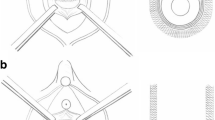Abstract
Introduction
Impact on sexual function has received little attention in the medical literature for a long time. Because of the site of insertion of permanent tension free vaginal tape (TVT) the G spot might be affected or the tape might interfere with arousal and sensory stimulation. Recent studies have reported varying degrees of sexual impairment after TVT insertion ranging from 0% to 15% including dyspareunia.
Aim
The aim of this study was to evaluate sexual function before and after suburethral sling removal due to postoperative female de novo dyspareunia. As a secondary outcome, general patients’ satisfaction with their overall continence situation was assessed.
Patients and methods
Between December 2005 and December 2007, we included 18 female patients who complained of de novo dyspareunia after suburethral sling insertion for urinary stress incontinence. All patients filled in an FSFI questionnaire prior to sling removal and at 3 months postoperatively. Additionally, all women were asked to estimate their general satisfaction regarding their continence situation using a Visual Analogue Scale (VAS) from 0 to 10, with 0 being the least satisfying situation and 10 being the most satisfying situation. All patients underwent gynaecological examination including ICS-pelvic organ prolapse staging (ICS-POP score).
Results
Of the 18 slings, ten were transobturator tapes (6 × TVT-O, 2 × Monarch, 2 × unknown) and eight were retropubic tapes (7 × TVT, 1 × SPARC). Desire, arousal, lubrication, satisfaction, and pain improved statistically significant. Orgasm scores were low with median scoring of 1.5 scores before and 1.0 scores after sling removal, and they did not change significantly after sling removal. The satisfaction rate deteriorated from a median of 7 (95% confidence interval [CI] 6.3–7.7) to a median of 4 (95% CI 3.7–5.1; p = 0.99) but not statistically significant.
Conclusions
Sexual function in patients with de novo dyspareuina is likely to improve after sling removal but not in all domains. Bladder function may deteriorate.


Similar content being viewed by others
References
Ulmsten U, Henriksson L, Johnson P, Varhos G (1996) An ambulatory surgical procedure under local anaesthesia for treatment of female urinary incontinence. Int Urogynaecol J 7:81–86
Hines TM (2001) The G-Spot: a modern gynaecologic myth. Am J Obstet Gynecol 185:359–362
Mazouni C, Karsenty G, Bretelle F, Bladou F, Gamerre M, Serment G (2004) Urinary complications after sexual function after the tension-free vaginal tape procedure. Acta Obstet Gynecol Scand 83:955–961
Maaita M, Bhaumik J, Davies AE (2002) Sexual function after tension-free vaginal tape for the surgical treatment of genuine stress incontinence. BJU Int 90:540–543
Ghezzi F, Serati M, Cromi A, Uccella Striacca P, Bolis P (2005) Impact of tension-free vaginal tape on sexual function: results of a prospective study. Int Urogynecol J 17:54–59
Rosen R, Brown C, Heiman J, Leiblum S, Meston C, Shabsigh R, Ferguson D, D’Agostino R Jr (2000) The Female Sexual Function Index (FSFI): a multidimensional self-report instrument for the assessment of female sexual function. J Sex Marital Ther 26(2):191–208
Karram MM, Segal JS, Vassallo BJ, Kleeman SD (2003) Complications and untoward effects on the tension-free vaginal tape procedure. Obstet Gynecol 929–993
Trammel C, Humdinger G, Schmidbauer J, Schatzl G, Madersbacher S (2000) Urinary incontinence in both sexes: prevalence rates and impact on quality of life and sexual life. Neurourol Urodyn 19:259–271
Cayan F, Dilck S, Akbay E, Cayan S (2008) Sexual functioning after surgery for stress urinary incontinence: vaginal sling versus Burch colposuspension. Arch Gynecol Obstet 277:31–36
Shah SM, Bukkapatnam R, Rodriguez LV (2005) Impact of vaginal surgery for stress urinary incontinence on female sexual function: is the use of polypropylene mesh detrimental? Urology 65:270–274
Mokate T, Wright C, Mander T (2006) Hysterectomy and sexual function. J Br Menopause Soc 12(4):153–157
Ghielmetti T, Kuhn P, Dreher EF, Kuhn A (2006) Gynaecological operations: do they improve sexual life? Eur J Obstet Gynecol Reprod Biol 129(2):104–110
Raina R, Pahlani G, Khan S, Gupta S, Agarwal A (2007) Zippe CD Female sexual dysfunction: classification, pathophysiology and management. Fertil Steril 88(5):1273–1284
Weber AM, Walters MD, Piedmonte MR (2000) Sexual function and vaginal anatomy in women before and after surgery for pelvic organ prolapse and urinary incontinence. Am J Obstet Gynecol 182(6):1610–1615
Francis WJ, Jeffcoate TNA (1961) Dyspareunia following vaginal operations. J Obstet Gynaecol Br Commonwealth 68:1–10
Haase P, Skibsted L (1988) Influence of operations for stress incontinence and 7 or genital descensus on sexual life. Acta Obstet Gynecol Scand 67(7):659–661
Haesakkers JP, Vierhout ME (2007) Some complications of tension-free midurethral tapes for the treatment of stress incontinence in women. Ned Tijdschr Geneeskd 151(24):1361–1366
Giberti C, Galoo F, Cortese P, Schenone M (2007) Transobturator tape for the treatment of female stress urinary incontinence: objective and subjective results after a mean follow-up of two years. Urology 69(4):703–707
Kuschel S, Schuessler B (2007) Results on function and safety of the Safyre-t, a hybrid transobturator vaginal sling for the treatment of stress urinary incontinence Neurourol Urodyn; Epub ahead of print
Ismail SI (2007) Audit of compliance with NICE guidelines on the use of tension-free vaginal tape slings for stress urinary incontinence. J Obstet Gynaecol 27(5):496–499
Abdel-Fattah M, Barrington JW, Arunkalaivanam AS (2004) Pelvicol pubovaginal sling versus tension-free vaginal tape for treatment of urodynamic stress incontinence: a prospective randomized three-year follow-up study. Eur Urol 46(5):629–635
Shechet J, Tannenbaum B, Fried SM (1999) Male dyspareunia in the uncircumcised patient. Am Fam Physician 60(1):54, 56
Whelan P (1977) Male dyspareunia due to short frenulum: an indication for adult circumcision. Br Med J 2(6103):1633–1634
Author information
Authors and Affiliations
Corresponding author
Rights and permissions
About this article
Cite this article
Kuhn, A., Burkhard, F., Eggemann, C. et al. Sexual function after suburethral sling removal for dyspareunia. Surg Endosc 23, 765–768 (2009). https://doi.org/10.1007/s00464-008-0058-y
Received:
Revised:
Accepted:
Published:
Issue Date:
DOI: https://doi.org/10.1007/s00464-008-0058-y




